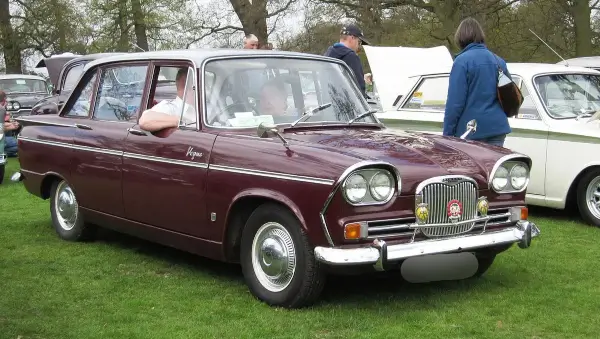Singer Tyres



Classic Singer Tyres
On the following pages, Longstone Classic Tyres give classic tyre fitment recommendations for Singer cars.
Vintage Singer Tyres
If your Singer is not listed, don't panic! Please give us a call on:
01302 711 123
or
Email: sales@longstonetyres.co.uk
Singer History
In 1905, George Singer introduced the first four-wheeled automobile, a two-seater with rubber tires, a spare wheel, and full all-weather equipment. After a successful run in the round Britain One Thousand Miles challenge in 1908, George Singer put four models on the market, ranging from a 7.9hp twin-cylinder to a 24.8hp four-cylinder. While the line was not very spectacular, it did firmly place the business in the rank of Britain's fledgling automotive sector.

Singer rose to prominence with the release of the 'Ten,' a two-seater with a channel-steel frame, four-cylinder engine, with transmission integrated into the rear axle. The 'Ten' broke away from the air-cooled, chain-driven cyclecars that were popular at the time, offering exceptional dependability and 40 miles per gallon, with a practical size of engine and body.
The Singer plant was shifted to war production, and the 'Ten' saw action in France, Egypt, Mesopotamia, Italy, and Salonika. By 1919, Singer was back in business with ten major items, the 'Ten,' with significant design changes, being the greatest seller. Prices climbed gradually as a result of post-war inflation, peaking in 1921 when Singer unveiled a brilliant sales gimmick in the shape of a free complete insurance coverage with each 'Ten' sold.
Highlights of the following years included the creation of a £250 four-seater family vehicle with a 10hp overhead valve engine in 1923; fabric saloons that were ahead of their time in 1924; and the legendary 'Junior'; powered by a new 848cc chain overhead camshaft engine in 1927. It was this extremely sophisticated and powerful engine that gave birth to the very popular performance cars of the 1930s, and from it sprang the series that lasted until 1958. Singer was the first British company to adopt independent front wheel suspension and a clutchless gearchange accomplished via the use of a fluid linkage, and they were the third-largest manufacturer in the United Kingdom, with over forty different models.

By 1934, the company was producing four and six-cylinder motors with side valves, overhead valves, and overhead camshafts ranging in power from 8hp to 18hp. In 1934, Singer also introduced the Airstream, a streamlined four-door sedan with built-in headlights. During WWII, the five Singer factories produced a wide range of important weaponry, including airframes for Wellington bombers, gun trailers, shell casings, pumps, Spitfire engine mountings, landing gear for aeroplanes, Halifax fuselages, and wing panels.
The Singer Roadster, with a 9hp engine, was introduced in March 1939 as an appealing modern 2-door 4-seater open-top automobile with a trunk that contained the spare wheel. The chassis was underslung at the back and was powered by a new 1074cc overhead-camshaft engine built lately for Singer's Bantam saloon vehicle, and the car sold briefly before manufacturing was halted due to the Second World War. Singer was eager to restart Roadster manufacturing in 1946, and the A model, a significantly modified vehicle, was introduced. The automobile had increased roughly 6" to allow rear-seat occupants extra legroom, and there had been other minor changes. In September 1949, a 4-speed transmission was fitted to create the 4A variant, which was solely available for export.

Up to this point in time, all Roadsters have used the dependable 1074cc 9hp engine, which, thanks to a wider cylinder bore, also powers the Super Ten saloon's 10hp engine, providing Singer with some uniformity of manufacturing. Meanwhile, Singer was working on a 1500 cc engine for their new SM1500 Saloon automobile, which debuted in October 1948. As a result, Singer had a more powerful motor available to slot into the Roadster and reap the benefits of mass production. The engine bay of the Roadster had to be enlarged to accommodate the physically larger engine, and as part of the restyling, the car received sleeker wings and a shorter radiator grille, as well as independent front suspension and larger, now hydraulic, front brakes, even though the rear brakes remained mechanically operated.
Rarer than the 4AC vehicles were a few SMX Roadsters with newly developed plastic bodywork and clean lines, which were later mirrored in the new Hunter saloon of 1954, the Hunter itself being an upgrade of the SM1500 Saloon. The Singer stockholders accepted an offer to join the Rootes organisation in 1955.
The immediate outcome was the Singer Gazelle, a predecessor of excellent, mid-sized automobiles that has seen a major surge in sales since the Rootes Group rescued the name from obscurity. The Vogue, which debuted in 1961, was supposed to be the Gazelle Mk IV, but because it was larger, heavier, and more costly, it was decided to add it to the lineup and give it a new name. In the late 1960s, Rootes/Chrysler felt the need to rationalise, the continuing existence of Singer was called into question, and the once-famous marque was altogether abandoned in 1970.
